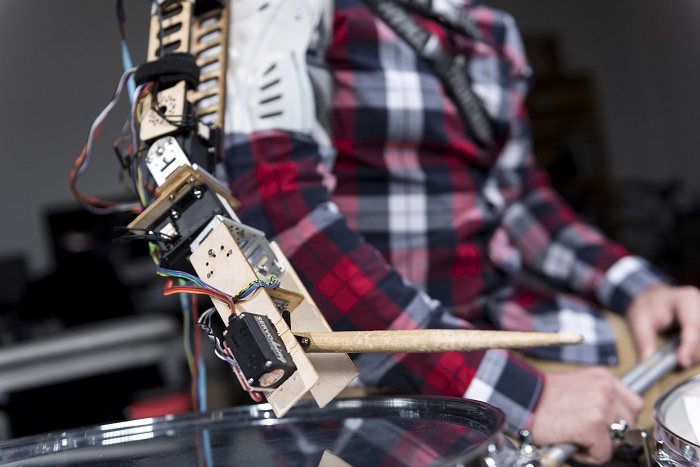Researchers at Georgia Institute of Technology have created a two-foot long “smart arm” that can be attached to a musician’s shoulder, for the purpose of allowing him / her to drum with three limbs.


The robotic arm responds to human gestures, and picks up beat and rhythm from the music being played. For example, should the drummer move to play the high-hat cymbal, the arm will maneuver itself to play the ride cymbal. Should the drummer switch over to the snare drum, the robotic arm will move on to the tom drum.
“If you augment humans with smart, wearable robotics, they could interact with their environment in a much more sophisticated manner,” said Georgia Tech Professor Gil Weinberg, director of the Center for Music Technology, who oversees the project. “The third arm provides a much richer and more creative experience, allowing the human to play many drums simultaneously with virtuosity and sophistication that are not otherwise possible.”
While the term “smart” is thrown around a lot these days, this robotic arm truly displays a higher level of intelligence. For one, it is aware of what it should play simply by listening to the music in the room. It’s also able to improvise based on the beat and rhythm it picks up; that is, if the musician plays slowly, the arm will slow its tempo, and if the drummer picks his / her speed up, it’ll play faster.
Another reason why it truly can be considered a “smart” device is because it knows its position at all times, as well as where the drums are, and the direction and proximity of the drummer’s arms. When the robot approaches the drum set, it uses built-in accelerometers to measure distance and proximity. The arm is outfitted with motors to ensure the drum stick is always parallel to the playing surface, and it will rise, lower, or otherwise twist itself to ensure full contact is made between it and the drum / cymbal.
Finally, the movement of the arm is not robotic in nature. It’s actually quite natural, with intuitive gestures. This is because of the fact that it was programmed using human motion capture technology.
“If you have a robotic device that is part of your body, it’s a completely different feeling from working alongside a regular robot,” said Weinberg. “The machine learns how your body moves and can augment and complement your activity. It becomes a part of you.”
See for yourself via the clip below:
Weinberg and his team of student researchers first began developing this technology as a prosthetic solution for an Atlanta drummer who lost an arm in an accident. The device they created had two sticks, one of which had a mind of its own. This replacement limb, if you will, allowed the drummer to continue playing music; in fact, he became so good at using the technology, he eventually went on to become known as the fastest drummer in the world.
The success of this project led Weinberg and his team to create this “third arm” robotic limb, something that any drummer can wear.
Looking ahead, the team wants to be able to link the robotic arm’s movements to brain activity. At present, experiments are underway in which the limb is paired with an electroencephalogram headband to detect the drummer’s brain patterns. It’s the group’s hope they’ll be able to identify patterns that the technology can use to enable the arm to react every time the musician thinks about changing tempo or instruments.
Weinberg is also thinking about applications for the robotic arm outside the world of music: “Imagine if doctors could use a third arm to bring them tools, supplies or even participate in surgeries. Technicians could use an extra hand to help with repairs and experiments,” he said. “Music is based on very timely, precise movements. It’s the perfect medium to try this concept of human augmentation and a third arm.”
Via the Georgia Institute of Technology
Advertisement
Learn more about Electronic Products Magazine





